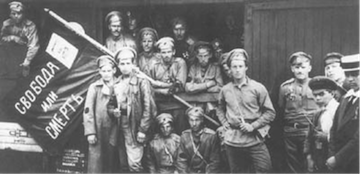

|
The Decisive Battles  White Troops ('Freedom or Death') Without an effective force to resist the Red Army, it was only a matter of time before the Komuch lost its hold on the Volga region. The SRs fled to Omsk where their brief Directory government was overthrown by the Rightist officers of the Siberian army who then invited Admiral Kolchak to become the Supreme Leader of the anti-Bolshevik movement. Backed by the British, the French and the Americans, Kolchak's White army, 100,000 men, advanced to within a few days' march of the Volga where the Bolsheviks were struggling to cope with a large peasant uprising behind their lines, during April 1919. Mobilizing thousands of party members for the Eastern Front, the Reds launched a desperate counter-offensive, pushing Kolchak's forces back to Ufa by mid-June, after which the cities of the Urals fell to the Reds like dominoes as the Whites fell apart and retreated through Siberia. Finally captured in Irkutsk, Kolchak was executed by the Bolsheviks in February 1920. At the height of the Kolchak offensive Denikin's forces in Rostov were in a good position to strike towards Tsaritsyn and link up with Kolchak on the Volga. The Reds might have been defeated if the two White armies had combined.  Makhno Instead Denikin led his men in the opposite direction to occupy the Donbas coal region and south-east Ukraine, where the Cossacks had taken up their arms against the Bolsheviks following a Red campaign of mass terror to clear them off the land ('decossackization'). With military support from the British and the French, Denikin's forces advanced easily into Ukraine. The Reds were suffering from a crisis of supplies and lost more than one million deserters on the Southern Front between March and October. In the south-east corner of Ukraine the Reds were heavily reliant on Nestor Makhno's peasant partisans, who fought under the black flag of the Anarchists but were no match for the better-supplied and disciplined White troops. |
© 2014 Orlando Figes | All Rights Reserved